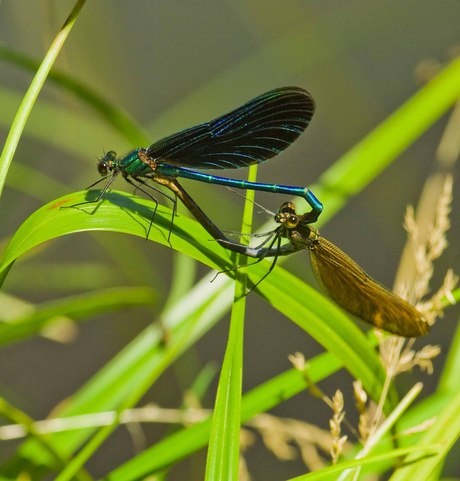Damselflies in distress — assortative mating could lead to extinction

Swedish researchers have studied mating preferences in damselflies, with assortative mating — the process of the female insect choosing her male partner based on size and other factors — found to break down the sexual barrier between species rather than preserve it. This could lead to species becoming extinct.
The researchers from Lund University studied the morphological variation of two closely related species of damselflies — the smaller banded demoiselle and the larger beautiful demoiselle. They assessed how this variation in appearance, shape and size affect the likelihood that damselflies mate, both within and between the two species.
The results, published in the journal Evolution, show that large females mate with large males within their own species, but also that some males of the smaller banded demoiselle species choose to mate with females of the larger beautiful demoiselle species. Additional experiments show that the power of attraction between different species mainly works in this direction, and not the other way around; that is, males of the larger species are not attracted to the females of the smaller species.
According to Erik Svensson, evolutionary biologist at Lund University, the size of the females reflects their reproductive capacity. This explains why the males of the smaller species are attracted to females of the larger species, as large females have high fecundity, ie, are highly capable of producing offspring. They probably also have a higher survival rate than small females.
“Mating patterns based on the size and quality of individuals partially counteract the sexual barrier between these two species,” said Svensson. “Our results also show that the sexual selection, when males compete for females, does not necessarily maintain the isolation between species — rather, it weakens it.”
When closely related species meet, males competing for females can in some cases lead to species becoming extinct, if the males of the smaller species are attracted to females of the larger species. Svensson believes the results could become important to nature conservationists in 10–20 years’ time, who may start to consider these aspects when trying to reintroduce or preserve endangered species.
Babies of stressed mothers likely to get their teeth earlier
Maternal stress during pregnancy can speed up the timing of teeth eruption, which may be an early...
Customised immune cells used to fight brain cancer
Researchers have developed CAR-T cells — ie, genetically modified immune cells manufactured...
Elevated blood protein levels predict mortality
Proteins that play key roles in the development of diseases such as cancer and inflammation may...





